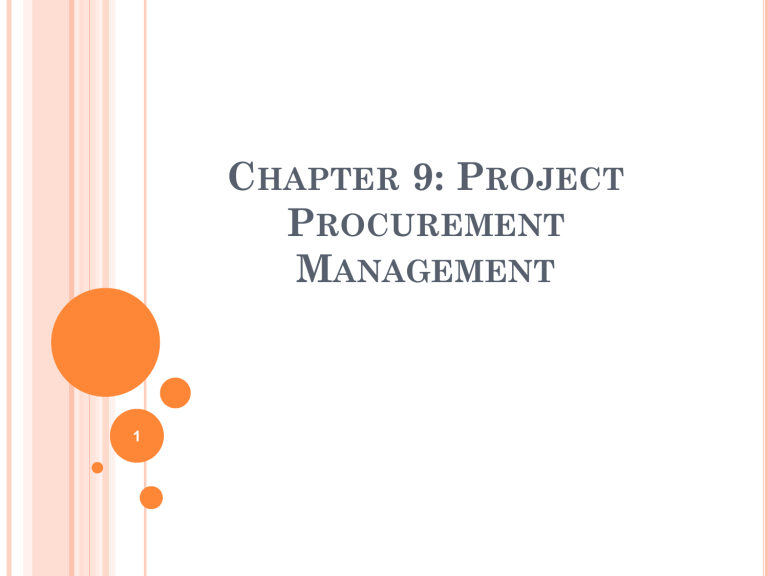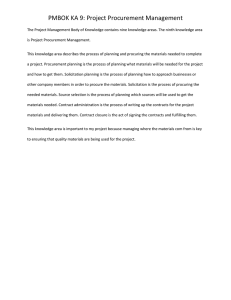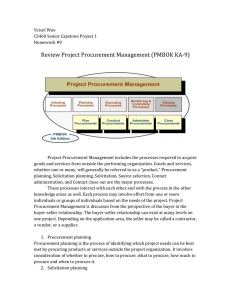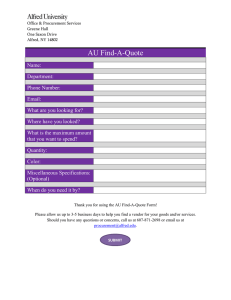
CHAPTER 9: PROJECT PROCUREMENT MANAGEMENT 1 IMPORTANCE OF PROJECT PROCUREMENT MANAGEMENT Procurement means acquiring goods and/or services from an outside source Other terms include purchasing and outsourcing 2 WHY OUTSOURCE? To reduce both fixed and recurrent costs To allow the client organization to focus on its core business To access skills and technologies To provide flexibility To increase accountability 3 PROJECT PROCUREMENT MANAGEMENT PROCESSES Procurement planning: determining what to procure and when Solicitation planning: documenting product requirements and identifying potential sources Solicitation: obtaining quotations, bids, offers, or proposals as appropriate Source selection: choosing from among potential vendors Contract administration: managing the relationship with the vendor Contract close-out: completion and settlement of the contract 4 PROJECT PROCUREMENT MANAGEMENT PROCESSES AND KEY OUTPUTS 5 PROCUREMENT PLANNING Procurement planning involves identifying which project needs can be best met by using products or services outside the organization. It includes deciding whether to procure how to procure what to procure how much to procure when to procure 6 COLLABORATIVE PROCUREMENT Several organizations, even competitors, have found that it makes sense to collaborate on procurement for some projects Kodak worked with several competitors to develop the Advantix Advanced Photo System 7 PROCUREMENT PLANNING TOOLS AND TECHNIQUES Make-or-buy analysis: determining whether a particular product or service should be made or performed inside the organization or purchased from someone else. Often involves financial analysis Experts, both internal and external, can provide valuable inputs in procurement decisions 8 STATEMENT OF WORK (SOW) A statement of work is a description of the work required for the procurement Many contracts, mutually binding agreements, include SOWs A good SOW gives bidders a better understanding of the buyer’s expectations 9 SOLICITATION PLANNING Solicitation planning involves preparing several documents: Request for Proposals: used to solicit proposals from prospective sellers where there are several ways to meet the sellers’ needs Requests for Quotes: used to solicit quotes for welldefined procurements Invitations for bid or negotiation and initial contractor responses are also part of solicitation planning 10 OUTLINE FOR A REQUEST FOR PROPOSAL (RFP) I. Purpose of RFP II. Organization’s Background III. Basic Requirements IV. Hardware and Software Environment V. Description of RFP Process VI. Statement of Work and Schedule Information VII. Possible Appendices A. Current System Overview B. System Requirements C. Volume and Size Data D. Required Contents of Vendor’s Response to RFP E. Sample Contract 11 SOLICITATION Solicitation involves obtaining proposals or bids from prospective sellers Organizations can advertise to procure goods and services in several ways approaching the preferred vendor approaching several potential vendors advertising to anyone interested A bidders’ conference can help clarify the buyer’s expectations 12 SOURCE SELECTION Source selection involves evaluating bidders’ proposals choosing the best one negotiating the contract awarding the contract It is helpful to prepare formal evaluation procedures for selecting vendors Buyers often create a “short list” 13 SAMPLE PROPOSAL EVALUATION SHEET 14 DETAILED CRITERIA FOR SELECTING SUPPLIERS 15 CONTRACT ADMINISTRATION Contract administration ensures that the seller’s performance meets contractual requirements Contracts are legal relationships, so it is important that legal and contracting professionals be involved in writing and administering contracts Many project managers ignore contractual issues, which can result in serious problems 16 SUGGESTIONS ON CHANGE CONTROL FOR CONTRACTS Changes to any part of the project need to be reviewed, approved, and documented by the same people in the same way that the original part of the plan was approved Evaluation of any change should include an impact analysis. How will the change affect the scope, time, cost, and quality of the goods or services being provided? Changes must be documented in writing. Project team members should also document all important meetings and telephone phone calls 17 CONTRACT CLOSE-OUT Contract close-out includes product verification to determine if all work was completed correctly and satisfactorily administrative activities to update records to reflect final results archiving information for future use Procurement audits identify lessons learned in the procurement process 18


